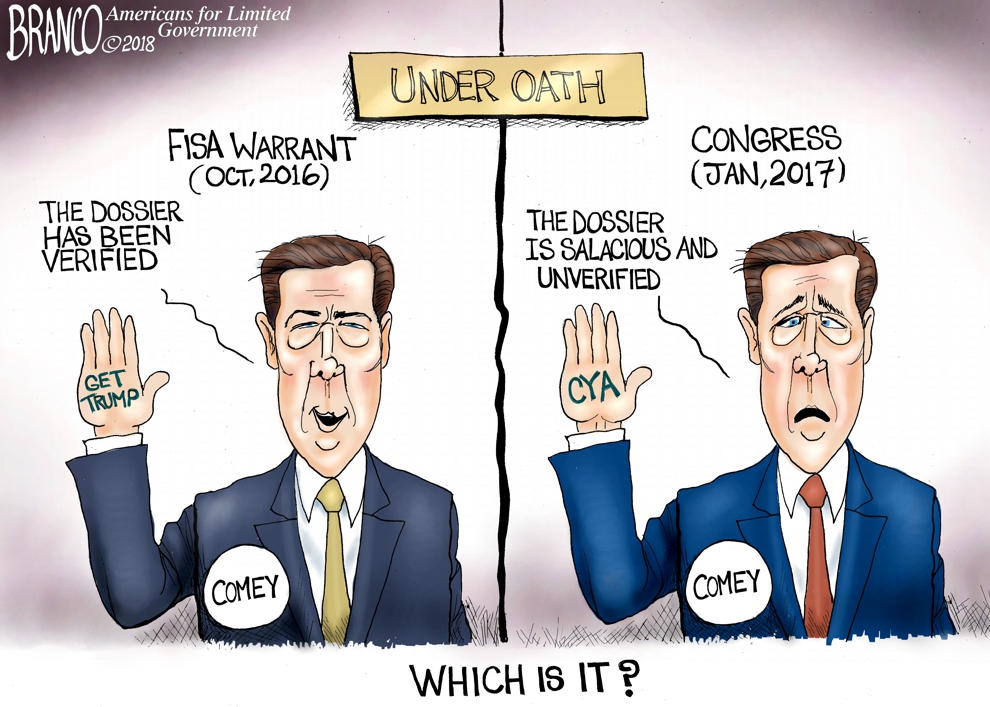Comey’s big lie
Posted by Richard on July 25, 2018
A.F. Branco wondered whether Comey lied in 2016 or in 2017. The answer is “Yes, and probably plenty of other times too.”

For instance, earlier this year Comey appeared to claim that the Steele dossier wasn’t critical to getting a FISA warrant to surveil Carter Page (and his “contacts,” meaning practically anyone in the Trump campaign).
Former FBI Director James Comey does not believe the infamous Steele dossier was necessary to obtain surveillance warrants against President Donald Trump’s former campaign adviser, Carter Page, Comey said Monday.
“Could there have been a FISA warrant without the Steele dossier?” PBS “News Hour” host Judy Woodruff asked Comey.
“It’s not my recollection that it was an essential part of any application,” he replied.
But note the weasely, Clintonesque wording, specifically the placement of the negative. Someone not parsing his words carefully to shade the meaning would have said, “It’s my recollection that it was not an essential part…”
Now that the Page FISA applications have been released (albeit heavily redacted), we know that the Nunes memo denounced by Democrats as full of lies was almost 100% accurate, that the Steele dossier was the first and primary evidence cited, that the FISA court was not made aware that it was paid for by Fusion GPS on behalf of Clinton and the DNC, and that James Comey signed off on the assertion that the information had been verified (emphasis in original):
On a sleepy summer Saturday, after months of stonewalling, the FBI dumped 412 pages of documents related to the Carter Page FISA surveillance warrants — the applications, the certifications, and the warrants themselves. Now that we can see it all in black and white — mostly black, as they are heavily redacted — it is crystal clear that the Steele dossier, an unverified Clinton-campaign product, was the driving force behind the Trump–Russia investigation.
Based on the dossier, the FBI told the FISA court it believed that Carter Page, who had been identified by the Trump campaign as an adviser, was coordinating with the Russian government in an espionage conspiracy to influence the 2016 election.
This sensational allegation came from Christopher Steele, the former British spy. The FISA court was not told that the Clinton campaign was behind Steele’s work. Nor did the FBI and Justice Department inform the court that Steele’s allegations had never been verified. To the contrary, each FISA application — the original one in October 2016, and the three renewals at 90-day intervals — is labeled “VERIFIED APPLICATION” (bold caps in original). And each one makes this breathtaking representation:
The FBI has reviewed this verified application for accuracy in accordance with its April 5, 2001 procedures, which include sending a copy of the draft to the appropriate field office(s).
…
Consider this: The representation that the FBI’s verification procedures include sending the application to “appropriate field offices” is standard in FISA warrant applications. It is done because the FBI’s Domestic Investigations and Operations Guide (DIOG) mandates that the bureau “ensure that information appearing in a FISA application that is presented to the [Foreign Intelligence Surveillance Court] has been thoroughly vetted and confirmed.”
…
In each Carter Page FISA warrant application, the FBI represented that it had “reviewed this verified application for accuracy.” But did the bureau truly ensure that the information had been “thoroughly vetted and confirmed”? Remember, we are talking here about serious, traitorous allegations against an American citizen and, derivatively, an American presidential campaign.
When the FBI averred that it had verified for accuracy the application that posited these allegations, it was, at best, being hyper-technical, and thus misleading. What the bureau meant was that its application correctly stated the allegations as Steele had related them. But that is not what “verification” means. The issue is not whether Steele’s allegations were accurately described; it is whether they were accurate, period. Were the allegations thoroughly vetted and confirmed by proof independent of Steele before being presented to the FISA court — which is what common sense and the FBI’s own manual mean by “verified”?
No, they were not.
Bottom line: We have evidence of collusion all right. There’s evidence of collusion between CIA Director George Brennan and the Russians. There’s evidence of collusion among various FBI and Justice officials to stop Trump before the election and to undermine his presidency afterward. What we don’t have is any credible evidence of collusion between the Trump campaign and the Russians.




Leave a Comment